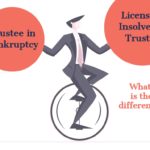

How does a consumer proposal work?
By Marc Nantel-Legault
The consumer proposal, the number one alternative to personal bankruptcy
The preferred debt relief solution in many cases, the consumer proposal allows you to take care of your financial problems while avoiding personal bankruptcy. It involves making an agreement with your unsecured creditors, which will be administered and validated by a licensed insolvency trustee. Unlike a consolidation loan, it is not based on a loan of money with interest, but on paying off some of your debt, based on your financial capacity and available assets.
Protection from collection agencies and from your creditors
The consumer proposal is a legal procedure that protects you against garnishments and harassment from your unsecured creditors. It also prevents interruptions of public services (electricity, telephone, etc.) and various recovery measures. that you could be the subject of.
Note that vehicle financing and mortgages are excluded from the stay of proceedings. Therefore, if you have decided to keep your vehicle or your home, you need to continue making the payments according to the contracts.
A win win solution for you and your creditors
The consumer proposal will allow you to group all of your debts in order to make a single monthly payment to your creditors, with 0% interest! This option is particularly attractive because it allows you not only to avoid bankruptcy, but also to offer your creditors less than you owe them. In some cases, this debt relief solution will let you repay 20% to 50% of the amount of your unsecured debts. Furthermore it spreads the repayment of your debts over a maximum period of five years.
After learning about your consumer proposal, your creditors will approve, negotiate, or reject your offer. In the majority of cases, your consumer proposal will be accepted, because your creditors will recover more money than if you went bankrupt. In addition, this option will allow you to keep your assets (house, car, furniture), and therefore your friends and family may not even notice your financial difficulties.
Note that the minimum term for a consumer proposal is two months, and the maximum term is five years.
Who can file a consumer proposal?
To be eligible for a consumer proposal, you must be an insolvent person whose total debts, excluding the mortgage on your principal residence, do not exceed $ 250,000 (or $ 500,000 in the case of a joint consumer proposal).
The consumer proposal may be suitable for anyone experiencing financial difficulties, and more particularly for people who own property they wish to keep and which, in the event of bankruptcy, could be sold for the benefit of your creditors, such as a residence.
The process of filing a consumer proposal
Step 1 : Review of your financial situation
We will review your financial situation, help you prepare a list of your assets and liabilities and review your budget, taking into account any other relevant information. He will then present the different solutions available to you and explain the advantages, disadvantages and consequences of each. Finally, he will give you recommendations. If he recommends that you proceed with a consumer proposal and you wish to proceed, your proposal will be filed with the Office of the Superintendent of Bankruptcy.
Step 2 : Notify your creditors and approval of the consumer proposal
Subsequently, we will send to all your known creditors the notice of your consumer proposal, along with a statement of your financial affairs, your budget and a proof of claim form. Your creditors will have 45 days to vote and / or request a meeting of creditors. At the expiration of the 45th day, if the trustee is not required to call a meeting, your proposal will be deemed accepted subject to a request for judicial review to be filed within 15 days of the (deemed) acceptance of the creditors. After this period has expired, your consumer proposal will be considered deemed approved by the court.
Step 3 : Your obligations after acceptance of your proposal
You must honor your commitments and make the monthly payment to your consumer proposal directly to the Licensed Insolvency Trustee. The funds are deposited into an in trust account and the licensed insolvency trustee will distribute money to your creditors, on a prorate basis of their provable claim, according to the terms of your consumer proposal.
As a consumer- debtor, you will have to respect certain obligations. In order to be eligible for a Certificate of Full Performance, you will need to:
- attend two consultation sessions; and
- make your payments agreed under the consumer proposal.
Step 4 : The full performance of the consumer proposal and debt discharge
Once you have fulfilled your obligations as set out in your consumer proposal, we will send you a certificate of full performance. You will then be released from all debts incurred before the date of your proposal, with the exception of debts referred to in section 178 of the Bankruptcy and Insolvency Act. Click on the following link to find out about non-dischargeable debts.
In the event of payment default
If you are no longer able to make your payments in accordance with your consumer proposal, we will assume that your financial problems are not completely resolved. We will therefore suggest that you consult again with a licensed insolvency trustee so that he can reassess your financial situation and assess the possibility of offering you another, more suitable option.
In some cases, issues beyond managing personal finances – such as gambling, alcohol or drug addiction – can jeopardize people’s ability to pay. If this is your case, it is important to talk to your trustee so that they can direct you to resources that can help you.
In the event of a default, which is usually after three cumulative late payments, the proposal will be deemed annulled, creditors’ rights restored and the stay of proceedings cease to apply. In addition, the deemed annulment will mean that you will no longer be entitled to make another consumer proposal until all proven creditors have been paid in full or have been settled.
There are possibilities to revive the proposal under certain conditions.
The impact on the credit report
The consumer proposal will affect your credit report. As soon as the consumer proposal is filed, the credit bureau will add the R9 annotation. Following full execution of your consumer proposal, the rating will be changed to R7 for a period of three years. In the Transunion file, the accounts will expire no later than six years after the start of the consumer proposal.
Note that it is possible to pay fully the obligations of your proposal before the scheduled term; this will remain on the credit bureau for a period of three years after full performance of your consumer proposal.
A solution often more advantageous than bankruptcy
Each situation is unique and it would be wrong to say that 100% of the time the consumer proposal would be more beneficial than bankruptcy. However, when filing for personal bankruptcy, the monthly average revenue must be reviewed during the bankruptcy and the cost and duration of the bankruptcy could change as a result. For example, if you file for bankruptcy and your income increases significantly, the amount payable will be revised upwards, which could cost you dearly.
If assets are at stake (house, RESP, TFSA, etc.), it is generally better to go with the consumer proposal, in order to keep them. When it comes to your credit rating, the consumer proposal is significantly more advantageous than a second or third bankruptcy. Generally, if the estimated total obligations for you to pay in a consumer proposal is less than two thousand dollars more than in a bankruptcy scenario, we will recommend the consumer proposal.
You have more questions about the consumer proposal?
We invite you to make an appointment with us to discuss your situation. The initial evaluation is free and confidential, with no obligation on your part and no initial costs. Take advantage of it!
You can also consult our article the top reasons you need to consider the consumer proposal.






